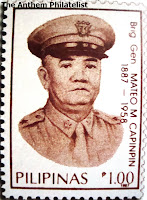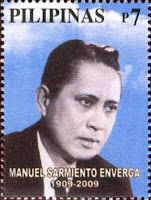The National Anthem of Mongolia
 The National Anthem of Mongolia was created in 1950. The music is a composition by Bilegiin Damdinsüren (1919 - 1991) and Luvsanyamts Murdorj (1915 - 1996), the lyrics were written by Tsendiin Damdinsüren (1908 - 1988).
The National Anthem of Mongolia was created in 1950. The music is a composition by Bilegiin Damdinsüren (1919 - 1991) and Luvsanyamts Murdorj (1915 - 1996), the lyrics were written by Tsendiin Damdinsüren (1908 - 1988).Over the twentieth century, Mongolia had several national anthems. The first one was used between 1924 and 1950. The second between 1950 and 1962, and a third one between 1961 and 1991. Since 1991, most of the anthem of 1950 is used again, but the second verse (praising Lenin, Stalin, Sükhbaatar, and Choibalsan) has been removed. On July 6th, 2006 the lyrics were revised by the Mongolian Parliament to commemorate Genghis Khan.
Khatagin Tsendiin Damdinsüren (1908-1986) was a Mongolian writer and linguist. He wrote the text to one version of the national Anthem of Mongolia. Damdinsüren was born in Mongolia 1908, in what is today the Dornod Aimag (province).
As a young man, he was politically active in the Mongolian Revolutionary Youth League, where he was elected into the Central Committee in 1926, and eventually became an editor of its publications. Later he became the chairman of the Council of Mongolian Trade Unions and was involved in the collectivization and seizures . He joined the MPRP in 1932. In 1933 he continued his education in Leningrad.
After returning to Mongolia in 1938, Damdinsüren became an ally of Yumjaagiin Tsedenbal, the future Premier Minister and President. He promoted the switch from the vertically written classical Mongolian script to an adapted Cyrillic script. He was forced to do it as he was politically repressed and imprisoned and was threatened by capital punishment. Later he confessed abandonment of the Classical Mongolian Script as one of the mistakes of his life. Between 1942 and 1946 he was an editor for the party newspaper Unen(The Truth). In 1959 he became chairman of the Committee of Sciences, and between 1953 and 1955 he was chairman of the Writers Union.
Damdinsüren wrote poetry that was well received in Mongolia. He also produced prose and literary studies, and a translation of The Secret History of the Mongols into modern Mongolian. The language of his poems and prose were largely based on the oral literary traditions of Mongolia, which he developed into a classical language of the Mongolian literature of the 20th century. His novel Gologdson huuhen (The Rejected Girl) became one of the popular films of 1960s.
He created the first large Russian-Mongolian dictionary and wrote the text to the national anthem that was in use between 1950 and 1962, and in parts after 1991.






